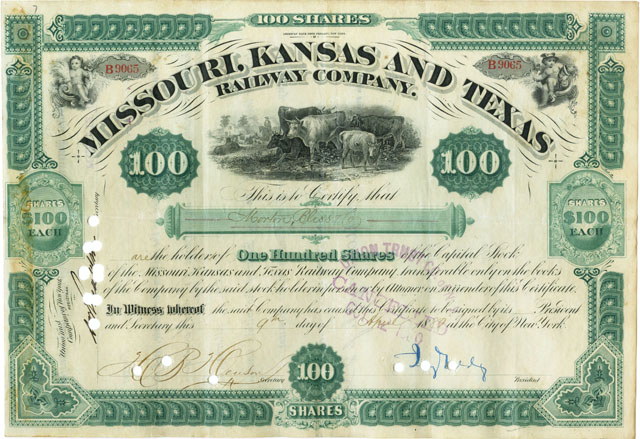Catalog numbering explained
| A typical catalog number looks like this: |
| MIS-716-S-17 |
| which represents three specific kinds of information: |
| MIS‑716 |
- |
S |
- |
17 |
| specific company |
|
type of certificate |
|
specific variety |
see more at
Company numbering |
|
see more at
Certificate types |
|
see more at
Variety numbering |
Inherent complexity
 MIS-716-S-17 with Jay Gould signature
MIS-716-S-17 with Jay Gould signature
I believe most collectors want simple cataloging system with easy-to-remember numbering and classifications. I could not agree more.
There's just one highly complicated problem that makes that goal impossible in this hobby. In the last two and a quarter centuries, hundreds of thousands of people have managed over 25,000 railroad companies and several times as many companies in other industries. Every company had different financing needs and every corporate manager had different ideas of how to go about raising money.
The net result was the production of countless varieties of documents that offered countless methods for people with money to invest. While the majority of the documents can be called "stocks certificates" and "bonds," and we squeeze them into those two major categories, we are left with a hodgepodge profusion of closely-related peripheral documents that functioned very differently. Lacking a certain inventiveness, I arbitrarily use the term, "other."
At present, this project has cataloged over 19,000 varieties and sub-varieties of those certificates in the North American railroad specialty. We are approaching about 2,000 in the specialty dedicated to coal mining in the United States, Mexico, and Canada.
Certificates are discovered randomly
Varieties appear randomly. Although I don't believe we will ever see more than a few percent of the number of varieties that once existed, I needed to design a numbering system sufficiently robust that it could absorb thousands of new listings. While a "simple" system was an ideal, the truth is that many collecting hobbies are littered with "simple" cataloging systems that failed. Simple systems fail because they are unable to accommodate complexities that develop with time and popularity. Overly simple systems tend also to be highly inflexible.
Designing cataloging systems for collectibles inevitably bumps up against a certain reality. Collectors don't seem to mind complex numbering systems. Sellers, however, tend to find them too burdensome. I must endure that reality.
The certificates I chose to catalog for this project are, by their very natures and numbers, highly complex and highly variable. That leads to complex numbering. Catalog numbers ARE hard to remember. I apologize.
Realities of the hobby
I fully understand that my cataloging system will never gain wide popularity. This catalog numbering system attempts to deal with several conflicting realities:
- Companies
- Existing certificates represent large numbers of railroad companies.
- Similar or identical company names are extremely common.
- Companies changed names frequently.
- Different company spellings may or may not represent different incorporations.
- Different incorporations may or may not be represented by different spellings.
- Every company needed different kinds of certificates.
- Certificates
- There are large numbers of identified varieties.
- More varieties are bound to appear.
- Some companies issued many varieties of certificates and some very few.
- An unknown percentage of certificates survive today.
- Certificate designs may have been used for one-time purposes or for long-running purposes.
- Minor differences between certificates are common.
- New certificates almost never appear in date order.
- Collector pricing
- Minor differences rarely attract different bids.
- Unlike the coin and stamp collectors, certificate collectors do NOT pay premiums for minor variations.
- Information
- Contributions from collectors are crucial.
- Collectors revel in identifying new varieties and sub-varieties.
- At the time of discovery, no contributor, myself included, will know whether any particular bit of information will end up being important or trivial.
- New information appears randomly.
- The number of "varieties" would grow significantly if every "flyspeck" variation were cataloged.
Catalog numbers out of date order
I want to make one final comment about certificate numbering. While I strive to keep variety numbering in date order, random discoveries intervene. Again, I apologize.